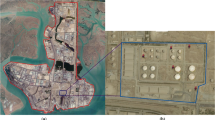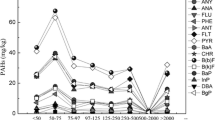Abstract
Surfactants are substances applicable in the removal of heavy metals from contaminated soil. This study aims to investigate the effects of surfactant mixtures, composed of nonionic, anionic, and cationic surfactants, on the removal efficiency of Cd and Zn by mixture design (MD). Central composite rotatable design (CCRD) was integrated to optimize the conditions of contaminated soil washing. However, as representatives of each type of surfactant, a single surfactant with the most effective Cd removal was selected for each type before MD and CCRD studies. Sodium dodecyl sulfate (SDS) and sodium laureth sulfate (SLES) were the most effective anionic surfactants, while dodecyl trimethyl ammonium bromide (DTAB) and polysorbate 80 (Tween 80) were chosen to represent cationic surfactants and nonionic surfactants, respectively. Two systems of SDS-DTAB-Tween 80 and SLES-DTAB-Tween 80 were studied to examine their roles in Cd and Zn removal by MD. The results indicate insignificant enhancement in mixed surfactant systems for Cd and Zn removal. DTAB was identified as an ineffective surfactant, but at present, the presence of Tween 80 in both systems compensated for the use of SDS and SLES. The system containing SLES was selected to study CCRD because of its low cost and biodegradation. Cd and Zn removal efficiencies were 45.2% and 47.7%, respectively, at 40 mmol/L of 5-mL SLES solution per gram of soil with a 200-rpm shaker speed for 8 h. The Cd concentration of treated soil met Thailand’s agricultural soil standard. However, the further increase in removal efficiency should be considered.

Graphical Abstract




Similar content being viewed by others
References
Abdin, Y., Usman, A., Ok, Y. S., Tsang, Y. F., & Al-Wabel, M. (2019). Competitive sorption and availability of coexisting heavy metals in mining-contaminated soil: Contrasting effects of mesquite and fishbone biochars. Environmental Research, 181, 108846. https://doi.org/10.1016/j.envres.2019.108846.
Andrejkovičová, S., Sudagar, A., Rocha, J., Patinha, C., Hajjaji, W., da Silva, E. F., et al. (2016). The effect of natural zeolite on microstructure, mechanical and heavy metals adsorption properties of metakaolin based geopolymers. Applied Clay Science, 126, 141–152. https://doi.org/10.1016/j.clay.2016.03.009.
Arteaga, G. E., Li-Chan, E., Vazquez-Arteaga, M. C., & Nakai, S. (1994). Systematic experimental designs for product formula optimization. Trends in Food Science & Technology, 5(8), 243–254. https://doi.org/10.1016/0924-2244(94)90017-5.
Assawadithalerd, M., Siangliw, M., & Tongcumpou, C. (2014). Effects of organic fertilizer on Cd bioavailability and Cd accumulation in rice grown in contaminated paddy soil. Applied Environmental Research, 36(3), 95–104. https://doi.org/10.35762/AER.2014.36.3.8.
Beiyuan, J., Tsang, D. C. W., Ok, Y. S., Zhang, W., Yang, X., Baek, K., et al. (2016). Integrating EDDS-enhanced washing with low-cost stabilization of metal-contaminated soil from an e-waste recycling site. Chemosphere, 159, 426–432. https://doi.org/10.1016/j.chemosphere.2016.06.030.
Cao, M., Ye, Y., Chen, J., & Lu, X. (2016). Remediation of arsenic contaminated soil by coupling oxalate washing with subsequent ZVI/air treatment. Chemosphere, 144, 1313–1318. https://doi.org/10.1016/j.chemosphere.2015.09.105.
Chemipan (2019a). Chemipan Corporation Co., Ltd. Sodium lauryl sulfate SLS. https://www.chemipan.com/a/en-gb/279-product/389-general-chemicals/5507-sodium-lauryl-sulfate-sls-1kg.html/ (accessed 16 September 2019).
Chemipan (2019b). Chemipan Corporation Co., Ltd. Texapon N70. https://www.chemipan.com/a/en-gb/279-product/389-general-chemicals/5387-texapon-n70-1kg.html (accessed 16 September 2019).
Conte, P., Agretto, A., Spaccini, R., & Piccolo, A. (2005). Soil remediation: Humic acids as natural surfactants in the washings of highly contaminated soils. Environmental Pollution, 135(3), 515–522. https://doi.org/10.1016/j.envpol.2004.10.006.
Elder, R. L. (1986). Final report on the safety assessment of cocamide DEA, lauramide DEA, linoleamide DEA, and oleamide DEA. Journal of American College of Toxicology, 5(5), 415–454.
FDA. (2018). Code of Federal Regulations, Title 21–Food and Drugs. Part 172-Food Additives Permitted for Direct Addition to Food for Human Consumption. https://www.accessdata.fda.gov/scripts/cdrh/cfdocs/cfcfr/CFRSearch.cfm?CFRPart=172. Accessed 1 March 2019.
Guo, X., Wei, Z., Wu, Q., Li, C., Qian, T., & Zheng, W. (2016). Effect of soil washing with only chelators or combining with ferric chloride on soil heavy metal removal and phytoavailability: Field experiments. Chemosphere, 147, 412–419. https://doi.org/10.1016/j.chemosphere.2015.12.087.
Hąc-Wydro, K., Pałasińska, I., & Miśkowiec, P. (2016). The comparative studies on the ability of anionic surfactants to bind lead (II) ions. Journal of Molecular Liquids, 219, 1071–1077. https://doi.org/10.1016/j.molliq.2016.02.067.
He, Z., Shentu, J., Yang, X., Baligar, V. C., Zhang, T., & Stoffella, P. J. (2015). Heavy metal contamination of soils: Sources, indicators, and assessment. Journal of Environmental Indicators, 9, 17–18.
Ishiguro, M., & Koopal, L. K. (2016). Surfactant adsorption to soil components and soils. Advances in Colloid and Interface Science, 231, 59–102. https://doi.org/10.1016/j.cis.2016.01.006.
Jung, J., Yang, J.-S., Kim, S.-H., & Yang, J.-W. (2008). Feasibility of micellar-enhanced ultrafiltration (MEUF) or the heavy metal removal in soil washing effluent. Desalination, 222(1–3), 202–211. https://doi.org/10.1016/j.desal.2007.01.154.
Kashif Uddin, M. (2017). A review on the adsorption of heavy metals by clay minerals, with special focus on the past decade. Chemical Engineering Journal, 308, 438–462. https://doi.org/10.1016/j.cej.2016.09.029.
Lee, A., & Kim, K. (2019). Removal of heavy metals using rhamnolipid biosurfactant on manganese nodules. Water, Air, & Soil Pollution, 230(11), 258. https://doi.org/10.1007/s11270-019-4319-2.
Li, X., Wu, Y., Zhang, C., Liu, Y., Zeng, G., Tang, X., et al. (2016). Immobilizing of heavy metals in sediments contaminated by nonferrous metals smelting plant sewage with sulfate reducing bacteria and micro zero valent iron. Chemical Engineering Journal, 306, 393–400. https://doi.org/10.1016/j.cej.2016.07.079.
Liao, X., Li, Y., & Yan, X. (2016). Removal of heavy metals and arsenic from a co-contaminated soil by sieving combined with washing process. Journal of Environmental Sciences, 41, 202–210. https://doi.org/10.1016/j.jes.2015.06.017.
Lingamdinne, L. P., Chang, Y.-Y., Yang, J.-K., Singh, J., Choi, E.-H., Shiratani, M., et al. (2017). Biogenic reductive preparation of magnetic inverse spinel iron oxide nanoparticles for the adsorption removal of heavy metals. Chemical Engineering Journal, 307, 74–84. https://doi.org/10.1016/j.cej.2016.08.067.
Makino, T., Maejima, Y., Akahane, I., Kamiya, T., Takano, H., Fujitomi, S., et al. (2016). A practical soil washing method for use in a Cd-contaminated paddy field, with simple on-site wastewater treatment. Geoderma, 270, 3–9. https://doi.org/10.1016/j.geoderma.2016.01.006.
Mukhopadhyay, S., Hashim, M. A., Sahu, J. N., Yusoff, I., & Gupta, B. S. (2013). Comparison of a plant based natural surfactant with SDS for washing of As(V) from Fe rich soil. Journal of Environmental Sciences, 25(11), 2247–2256. https://doi.org/10.1016/S1001-0742(12)60295-2.
Mukhopadhyay, S., Mukherjee, S., Adnan, N. F., Hayyan, A., Hayyan, M., Hashim, M. A., et al. (2016). Ammonium-based deep eutectic solvents as novel soil washing agent for lead removal. Chemical Engineering Journal, 294, 316–322. https://doi.org/10.1016/j.cej.2016.02.030.
NIH (2010a). U.S. National Library of Medicine. HSDB: POLYSORBATE 20. https://toxnet.nlm.nih.gov/cgi-bin/sis/search2/r?dbs+hsdb:@term+@DOCNO+4359/ (accessed 1 April 2019).
NIH (2010b). U.S. National Library of Medicine. HSDB: POLYSORBATE 80. https://toxnet.nlm.nih.gov/cgi-bin/sis/search2/r?dbs+hsdb:@term+@DOCNO+4359/ (accessed 1 April 2019).
NIH (2011). National Center for Biotechnology Information. PubChem Database. CID=23665884. https://pubchem.ncbi.nlm.nih.gov/compound/23665884/ (accessed 1 April 2019).
NIH (2019). National Center for Biotechnology Information. PubChem Database. Sodium lauryl sulfate, CID=34232651. https://pubchem.ncbi.nlm.nih.gov/compound/3423265 (accessed 1 April 2019).
ONEP (2004). Soil quality standard. http://www.pcd.go.th/info_serv/reg_std_soil01.html/ (accessed 15 February 2018).
Park, B., & Son, Y. (2017). Ultrasonic and mechanical soil washing processes for the removal of heavy metals from soils. Ultrasonics Sonochemistry, 35, 640–645. https://doi.org/10.1016/j.ultsonch.2016.02.002.
Parus, A., & Framski, G. (2018). Synthesis, characterization, and evaluation of toxicity of quaternary ammonium chlorides of glucose-based ester. Turkish Journal of Chemistry, 42, 1095–1104. https://doi.org/10.3906/kim-1711-35.
Race, M., Marotta, R., Fabbricino, M., Pirozzi, F., Andreozzi, R., Cortese, L., et al. (2016). Copper and zinc removal from contaminated soils through soil washing process using ethylenediaminedisuccinic acid as a chelating agent: A modeling investigation. Journal of Environmental Chemical Engineering, 4(3), 2878–2891. https://doi.org/10.1016/j.jece.2016.05.031.
Rosen, M. J. (2004). Surfactants and interfacial phenomena (3rd ed.). New Jersey: John Wiley & Sons, Inc..
Sakai, H., Matsuoka, S., Zinchenko, A. A., & Murata, S. (2009). Removal of heavy metal ions from aqueous solutions by complexation with DNA and precipitation with cationic surfactant. Colloids and Surfaces A: Physicochemical and Engineering Aspects, 347(1–3), 210–214. https://doi.org/10.1016/j.colsurfa.2009.04.031.
Sasol. (2018). Safety data sheet: Alfonic(R) 1412–7 ethoxylate. http://www.sasoltechdata.com/MSDS/A14127.pdf.
Shen, L.-C., Nguyen, X.-T., & Hankins, N. P. (2015). Removal of heavy metal ions from dilute aqueous solutions by polymer–surfactant aggregates: A novel effluent treatment process. Separation and Purification Technology, 152, 101–107. https://doi.org/10.1016/j.seppur.2015.07.065.
Sigma-Aldrich. (2019). Safety data sheet: Dodecyltrimethylammonium bromide. https://www.sigmaaldrich.com/MSDS/MSDS/DisplayMSDSPage.do?country=TH&language=en&productNumber=D8638&brand=SIGMA&PageToGoToURL=https%3A%2F%2Fwww.sigmaaldrich.com%2Fcatalog%2Fproduct%2Fsigma%2Fd8638%3Flang%3Den.
Tadros, F. (2005). Applied surfactants: Principles and applications. Weinheim: WILEY-VCH Verlag GmbH & Co. KGaA.
Torres, L. G., Lopez, R. B., & Beltran, M. (2012). Removal of As, Cd, Cu, Ni, Pb, and Zn from a highly contaminated industrial soil using surfactant enhanced soil washing. Physics and Chemistry of the Earth, Parts A/B/C, 37–39, 30–36. https://doi.org/10.1016/j.pce.2011.02.003.
Varshney, K. G., Rafiquee, M. Z. A., & Somya, A. (2007). Effect of surfactants on the adsorption behaviour of tin (IV) phosphate, cation exchanger for alkaline earths and heavy metal ions. Colloids and Surfaces A: Physicochemical and Engineering Aspects, 301(1–3), 224–228. https://doi.org/10.1016/j.colsurfa.2006.12.061.
Wang, G., Zhang, S., Xu, X., Zhong, Q., Zhang, C., Jia, Y., et al. (2016). Heavy metal removal by GLDA washing: Optimization, redistribution, recycling, and changes in soil fertility. Science of the Total Environment, 569–570, 557–568. https://doi.org/10.1016/j.scitotenv.2016.06.155.
Wei, M., Chen, J., & Wang, X. (2016). Removal of arsenic and cadmium with sequential soil washing techniques using Na2EDTA, oxalic and phosphoric acid: Optimization conditions, removal effectiveness and ecological risks. Chemosphere, 156, 252–261. https://doi.org/10.1016/j.chemosphere.2016.04.106.
Xiang, B., Fan, W., Yi, X., Wang, Z., Gao, F., Li, Y., et al. (2016). Dithiocarbamate-modified starch derivatives with high heavy metal adsorption performance. Carbohydrate Polymers, 136, 30–37. https://doi.org/10.1016/j.carbpol.2015.08.065.
Yang, Z., Zhang, S., Liao, Y., Li, Q., Wu, B., & Wu, R. (2012). Remediation of heavy metal contamination in calcareous soil by washing with reagents: A column washing. Procedia Environmental Sciences, 16, 778–785. https://doi.org/10.1016/j.proenv.2012.10.106.
Zhang, W., Tsang, D. C. W., & Lo, I. M. C. (2007). Removal of Pb and MDF from contaminated soils by EDTA- and SDS-enhanced washing. Chemosphere, 66(11), 2025–2034. https://doi.org/10.1016/j.chemosphere.2006.10.017.
Zhao, J., Liu, J., Li, N., Wang, W., Nan, J., Zhao, Z., et al. (2016). Highly efficient removal of bivalent heavy metals from aqueous systems by magnetic porous Fe3O4-MnO2: Adsorption behavior and process study. Chemical Engineering Journal, 304, 737–746. https://doi.org/10.1016/j.cej.2016.07.003.
Acknowledgments
This work was supported by the Faculty of Environment and Resource Studies, Mahidol University. The authors appreciatively acknowledge the Faculty of Environment and Resource Studies, Mahidol University, and the Remediation Technologies for Petroleum Contamination Research Program, Center of Excellence on Hazardous Substance Management (HSM), Chulalongkorn University for the laboratory instrument support.
Funding
This work was supported by the Faculty of Environment and Resource Studies, Mahidol University (grant numbers 59–02).
Author information
Authors and Affiliations
Corresponding author
Ethics declarations
Conflict of Interest
The authors declare that they have no competing interests.
Additional information
Publisher’s Note
Springer Nature remains neutral with regard to jurisdictional claims in published maps and institutional affiliations.
Highlights
•Mixture design is applicable to the prediction of spatial removal efficiency.
•Central composite rotatable design is useful to optimize metal removal conditions.
•Mixed nonionic, anionic, and cationic surfactants cannot increase Cd removal.
•SLES performs well, removing Cd and Zn from soil respectively up to 45.2% and 47.7%.
Electronic Supplementary Material
ESM 1
(DOCX 19 kb)
Rights and permissions
About this article
Cite this article
Assawadithalerd, M., Phasukarratchai, N. Optimization of Cadmium and Zinc Removal from Contaminated Soil by Surfactants Using Mixture Design and Central Composite Rotatable Design. Water Air Soil Pollut 231, 329 (2020). https://doi.org/10.1007/s11270-020-04704-w
Received:
Accepted:
Published:
DOI: https://doi.org/10.1007/s11270-020-04704-w




